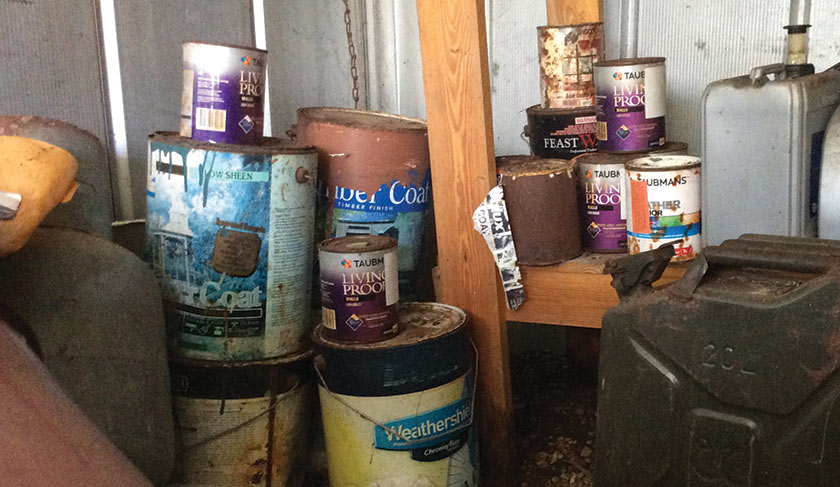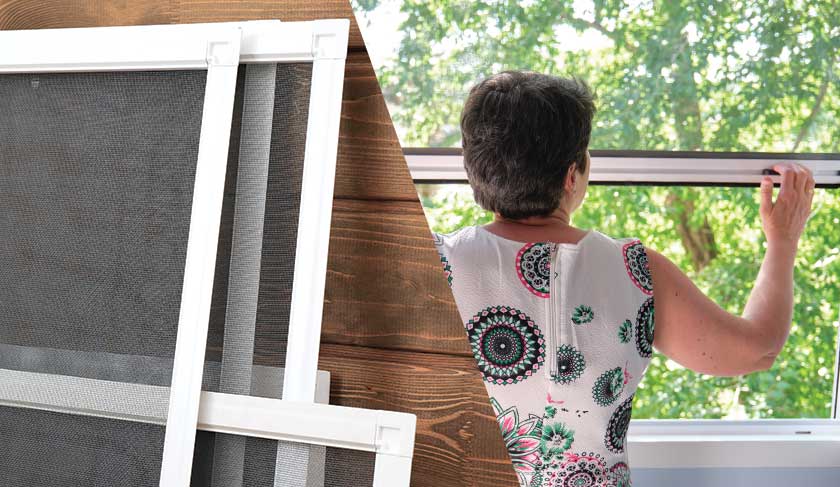Got paint cans in your shed that you have no idea how to dispose? In this article, Sara discusses how to dispose paint cans safely and in an environmentally friendly manner, including latex paint cans and spray paint cans.
When we moved into our run-down country home, the previous owners left us with a plethora of junk in the sheds and under the house. Some of it was useful like the free ride-on lawnmower (cool), but most of it was rat-infested, spider-infested, water-damaged or rusty trash. And some of it is still sitting there after five years, because I have no idea what to do with it… like, this pile of old paint cans:

Even if you have not unwittingly acquired a bunch of old paint cans like we have, chances are that after finishing a painting project, you have been left over with several paint cans with at least some paint still in them. If you’ve come to this article you are probably also wondering what on earth to do with them.
Fortunately, properly disposing of paint cans, including latex paint and spray paint cans, is not a difficult task. In this article, I explain how to dispose paint cans safely and in an environmentally-friendly manner.
House Paint & Latex: How to Dispose Paint Cans
Dry It Out First
Your first step in disposing of paint cans properly is to dry the paint out.
Remove the lid and put the can somewhere dry, preferably outdoors, for as long as it takes to dry. Of course, this will only work if you have just a small bit of paint left; you wouldn’t do this for a full tin. For larger quantities of paint, this flyer from New York State instructs users to mix kitty litter into the paint (equal quantities of paint to kitty litter), to assist it drying out.
Regardless of the type of paint that you are working with, paint is for all intents and purposes, plastic. When you dry out the paint first, you can easily scrape or peel out the hardened paint and separate it from the metal can. Even when dealing with plastic paint cans, it’s always best to let the paint dry out completely first before throwing it away.
Once the paint is removed, you can reuse or repurpose the paint can, or throw it into your recycling if your local government regulations allow it. If it’s a plastic can, you should double-check that type of plastic can be recycled in your region. Keep in mind, some governments may consider it hazardous waste, even if the paint has been cleaned out.
As for the dried paint, you will need to check your local government regulations or with your disposal company if you are allowed to throw out that dried-out paint with the rest of your household garbage. This will vary from region to region, depending on where you live. Where I live it is ok to throw in the regular rubbish, but other regions may classify it as hazardous waste.

Donate It
If the paint is still in good condition, the best way to get rid of extra paint is to simply donate it.
There are countless organizations located around the world that accept partially finished gallons of paint. For example, there are a number of organizations that build homes for needy families and are always looking for donations of building supplies. Have a look online at your local region to see if there are any such groups.
If you aren’t going to use the paint again for painting your own walls, then first check with a friend to see if they need any. Maybe your local schools have a project coming up and they need some extra paint. Or, take a picture and throw it up on Facebook Marketplace or some other buy/swap group as freebie, and there’s a good chance someone will be happy to come to your door and take it off your hands.
Save It for Later
In the end, it is important to remember that latex paint can be stored for up to 10 years if properly secured, while oil-based paints can last up to 15 years. After all, you never know when there’s going to be a need for you to touch up something in and around your home. Always make sure to keep the paint in its original container, and seal it up properly for later use. Then as long as you store it in a dry, cool place, that is away from direct sunlight, it should last an extremely long time before it has to be thrown away. Once the paint has reached its age limit, it will develop hard lumps, and may even smell foul.
Look for Disposal Sites and Companies
While it is best to reuse or donate paint in good condition, professional disposal is a better option when you have a large amount of leftover paint or the paint you have is very old, dirty, or discolored.
Disposal options vary by country and region depending on local regulations. There could be government-run hazardous waste drop-off points located in and around your area. Alternatively, there are also professional companies that will accept your old paint, whether it is for donation purposes or waste disposal.
For example, the LA County runs a program for recycling paint cans, and PaintCare operates a paint recycling program throughout several states in the United States.
Meanwhile, in Australia the PaintBack organization collects and disposes of used paint cans, from a number of collection points located nation-wide. In Australia, the state of New South Sales (NSW) also offers Community Recycling Centres where you can drop off paint free of charge.
How to Dispose Spray Paint Cans
Although they may seem more difficult than any other type of paint can to dispose of, spray paint cans are actually easy to get rid of. Essentially, they are just an aerosol can.
Make Sure the Can Is Empty
In order to properly dispose of a spray paint can, the first step is to ensure that the can is completely empty. As a general rule, completely empty spray paint cans can be disposed of or recycled with the rest of your household waste. The one exception to this rule is if this still has pressure inside.
When you are ready to throw a can of spray paint away, flip it upside down and spray away to make sure that there are no more solids left in the can. Once the solids are gone, you may still need to depressurize the can before you can dispose of it.
Depressurize the Can
Even after all of the fluids have been expelled from a spray paint can, they can still be full of compressed air. If they are punctured or crushed, they can even explode.
Some government locations may also have specific regulations in place regarding the proper depressurization of cans before they may be recycled. You will need to check with your local recycling organizations to determine the best way to depressurize the can if it still has air in it.
Do Not Remove the Nozzle
Although it may seem like a good idea to remove the nozzle in order to separate the plastic from the metal, it is not recommended to do so. Certainly, the nozzle contains other materials including plastic and rubber, but you should never attempt to remove it because of the possibility of explosion. Besides, the amount of plastic in the nozzle is very little, and it’s not really worth recycling.
Final Thoughts
I hope this article has given you a good overview of how to dispose paint cans, both house paint cans and how to dispose spray paint cans.
After researching and writing this article, I plan to dispose our paint cans at our local Community Recycling Centre in Australia, through the PaintBack system. Now all I need to do is convince my lovely partner that no, we don’t need to keep hoarding them forever.
Since paint disposal schemes and regulations vary so widely from country to country, and state to state, it is always best to check with your local government or paint disposal companies the right way to dispose of paint cans in your area beforehand.
Author
-

Hey, I’m Sara, co-owner of NestKoo! I’m a graphic designer and professionally trained fine artist, with a Bachelor of Arts (Fine Art) majoring in Painting. I love being close to nature, sustainable living and bringing new life to old things. My specialty in NestKoo is DIY house painting, upholstery and furniture upcycling, where I bring my skills in fine art painting and contemporary design together into a practical home DIY context.
View all posts









